Juniper Publishers-Journal of Ophthalmology
Abstract
Background: The burrowing owl
(Athene cunicularia) has peculiar visual capacity, presenting
conspicuous vision, what can be justified, among other motives, by the
presence of cones and rods in the macula and the existence of double
cones. The Athene cunicularia presents retinal cell circuit highly
organized and complex, with presence of two foveae. Thickening in the
ganglion cell layer surrounding the fovea contributes to the change of
the refractive index of the retina at this location, thus increasing the
sensitivity for detecting motion. The high concentration of
photoreceptors in the fovea is the cause of the maximum optical
resolution of this region.
Results: We conduct a
transversal observational study according to the protocol of the
International Society for Clinical Electrophysiology of Vision (ISCEV)
that aims at evaluating the retinal response of the species after
stimulation with white light, both in photopic and scotopic stimuli. The
verification of the p-value and t-value, we obtained for the variables,
respectively: a-wave amplitude - 0.02 and 2.94; b-wave amplitude - 0.12
and 1.76; b-wave time culmination - 0.07 and 2.12;b-wave latency - 0.74
and 0.34.
Conclusion:In order to
standardize the variables of the electroretinogram of the species, the
authors propose to evaluate the electroretinogram components under white
light in both stimuli, providing electrophysiological data from the
visual stimulation of retinal species, encouraging the Biological
Sciences with substrate for future research and clinical evaluations.
Keywords: Owls; Electroretinography; RetinaAbbreviations: CEPAL: Ethics Committee of Faculty of Medicine of Health Sciences Center in Federal University of Rio de Janeiro; ERG: Electro Retino Gram; IBAMA: Brazilian Institute of Environment and Renewable Natural Resources; ISCEV: International Society for Clinical Electrophysiology of Vision
Introduction
The retinal electrical activity corresponds to the
initial event processing of visual information. All animal species that
have visual apparatus present some retinal response, so that the
comparative study of different species allows us to acquire knowledge
that can be applied in our daily lives.
It is true that most treatments used in humans result
from applications arising from animal research. Knowledge of cytology,
histology and physiology of the human race is due to the various animal
studies.
The owls are known for their great visual capacity
due to their complex retinal structure. As an interesting kind of
vertebrates, the investigation of their visual apparatus operation is of
most importance. The existence of a previous study on the morphology of
photoreceptors and the evaluation of the b-wave of electroretinogram
(ERG) in various color spectra in Athene cunicularia (Burrowing Owl) motivated acomplementary electroretinographic study of the specie concerned [1].
The visual capacity of owls presents peculiarities,
among them, their big eyes which account for 1-5% of body weight,
depending on the species. They have binocular vision, which provides
them stereopsis. Their total visual field is 110°, having 70° binocular
vision. Their eyes are large to increase their efficiency, especially
under low light conditions and are so well developed that they are not
rounded, but tubular. They are protected by three structures, the upper
eyelids, lower and the
nictitating membrane [2].
The retina of Athene cunicularia has mixed fovea, with a
predominance of rods, observing the eight rods relationship
for two simple cones and a double cone [3-5]. The presence
of a double cone only occurs in some species [6-8]. Another
important morphological appearance in the retina of these birds
(including the Athene cunicularia) is the presence of aster, a
structure mainly composed of axons of bipolar cells that have
oblique direction and centrifugal to the fovea, allowing for a
retinal neuronal rearrangement circuit area resulting from the
central area [6,9-11].
The Athene cunicularia presents a retinal cell circuit extremely organized and complex. Thickening in the ganglion cell layer
surrounding the fovea contributes to the change of the refractive
index of the retina at this location, thus increasing the sensitivity
for movement’s detection [12-15]. The high concentration of
photoreceptors in the fovea is what accounts for the maximum
optical resolution of this region [3]. The Athene cunicularia does
not present differentiated retinal electrical response to some
light spectra in photopic and scotopic environment, when taking
into account the latency and amplitude of b-wave [1].
In order to standardize the variables of the electroretinogram
of the species, the authors, following their line of research, have
proposed to evaluate the electroretinogram components under
white light in both environments (Figure 1 and 2).
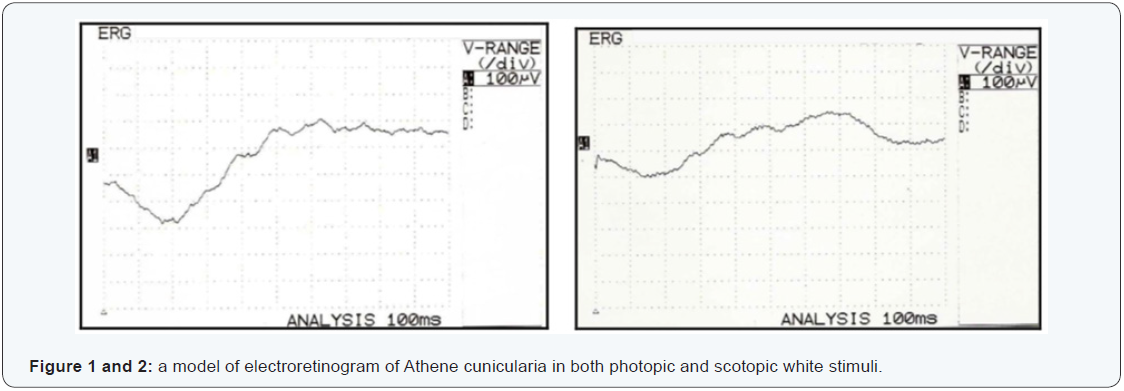
The Athene cunicularia has twilight hunting habits and
previous histological descriptions identified outer segments of
the long rods, which can justify their twilight habit [3, 16-19].
Discrimination of colors in owls was reported, as well as
the light wavelength, which is not important for the behavior
of owls [20]. Although the vision of the owls is not as sensitive
as previously thought, it still has advantages over the diurnal
species at low levels of luminosity [21]. The hearing of Owls is
essential for their predatory activity, serving to detect and hunt
their prey [22, 23] their vision is intended to determine the
spatial orientation, distance and speed fly [24].
The cross-sectional observational study of the species
in question was chosen due to the existence of previous
morphological and electrophysiological documentation [1],
which will be supplemented by the electrophysiological data
obtained by applying the diffuse Flash ERG in vivo.
Objective
Presenting the electroretinographic record of Athene
cunicularia, identifying their components when the retina is
stimulated by the white light spectrum in photopic and scotopic
conditions, as well as the relationship between the answers found in both responses and their influence on living species.
Providing electrophysiological visual stimulation data of retinal
species, encouraging the Biological Sciences with substrate for
future research and clinical evaluations.
Materials and Methods
Animals
We studied seven species of owls Athene cunicularia, of both
genders, provided by the Brazilian Institute of Environment and
Renewable Natural Resources (IBAMA). The animals weighed
between 180 - 205 g, and height between 21.8 - 26 cm.
The research protocol complies with the requirements of
the Ethics Committee of Faculty of Medicine of Health Sciences
Center in Federal University of Rio de Janeiro (protocol number
14/2004) and IBAMA (protocol number 02022.000518/2005-
33).
Methodology of Electroretinography Exam
In order to accomplish the study, we considered as inclusion
criteria:
- Animals of both genders;
- Absence of general and ophthalmic anatomical changes;
- Weight within the required standards in the literature; and
- No vitreoretinal pathologies.
The exclusion factors
- Failure to comply with, at least, one of the items of the inclusion criteria.
Following the study protocol, the animals were sedated with
ketamine sulfate (20 mg / kg) intramuscular; mydriasis was
obtained with topical 1% tropicamide, in a total of three drops
per eye. After mydriasis, direct ophthalmoscope was performed
on both eyes to exclude vitreoretinal opacities and then topical
corneal anesthesia with 0.4% oxybuprocaine hydrochloride at a
dose of three drops per eye with thirty second intervals between
each drop.
Following the procedures of sedation and anesthesia,
three electrodes needle-shaped 13 x 0.45 mm were used for
examination. One of the electrodes was introduced into the
corneal stroma, causing a self-sealing injury, without the need
for sutures or bandages; the other two were inserted into the
subcutaneous, one superiorly and between the animal eyes
(ground electrode) and the other (reference electrode) in the
supraorbital region of the eye to be examined. The electrodes
were placed one minute prior to the light stimulus.
Among the fourteen eyes stimulated, seven were destined
to photopic response and seven to scotopic response, the choice
being made randomly, so that the photopic documentation was
obtained of the right eyes and the scotopic documentation of the
left eyes.
The electroretinography device used was Neuropack II®,
of the company Nihon Koden®. The flash lamp used in all tests,
either scotopic or photopic stimuli, had intensity of 20 Joules
being performed with stimulator located 30 cm from the animal.
The parameters used for electroretinogram record followed
the protocol established by the International Society for Clinical
Electrophysiology of Vision (ISCEV) 2004, except for the use of
summit Ganzfield (full field), unavailable in the Ophthalmology
Department of the Federal University of Rio de Janeiro. The
electrodes used were the same and had the same impedance.
The duration of the light stimulus was <5 ms. The time to adapt
to light to stimulate in photopic environment was 10 minutes
and the dark adaptation to stimulus in scotopic environment
was 20 minutes [25]. Registered stimuli contemplated white
electromagnetic spectrum, visible to man.
Analysis of results
The type of study used was cross-sectional observational
analysis, demonstrating the electroretinogram of Athene
cunicularia in photopic and scotopic response.
For the evaluation of the data obtained were considered the
following conventions:
- -a-wave amplitude: distance between the most negative point of the a-wave and the level of the beginning of the electroretinogram. Unit in microVolts;
- -b-wave amplitude: distance between the most positive point of b-wave and the most negative level of the electroretinogram. Unit in microVolts;
- -b-wave time culmination: distance between the beginning of the stroke and the most positive point of the b- wave. Unit in milliseconds;
- -b-wave latency: distance between the beginning of the stroke and the most negative point of b-wave. Unit in milliseconds.
With reference to the light stimulus studied, we obtained the
mean and standard deviation of the above parameters. Due to
the small sample used, the statistical evaluation was performed
by Student’s t-test two-tailed paired, compared to the same
variable in both environments. We determined the error rate (α)
of the applied test in order to validate the comparison made. The
values of “p” were evaluated for each comparison (photopic or
scotopic) and its specific variable.
Results
The electroretinography results of Athene cunicularia were
obtained in both photopic and scotopic responses, by being
observed all variables proposed for the analysis. They were
registered as uneventful strokes in both environments such
as under the protocol. They were identified and recorded in
the electroretinogram components: a-wave amplitude, b-wave
amplitude, the completion time and latency of b-wave.
The t-Student two-tailed paired test was carried out from
the same spectrum of light (white), and the same variable in
both stimuli, respecting null hypothesis the equality between
stimulated conditions, checking that, with an error margin of
1%, there was no rejection of the null hypothesis for all evaluated
variables.
The verification of the p-value and t-value, we obtained for
the variables, respectively:
- - a-wave amplitude - 0.02 and 2.94;
- -b-wave amplitude - 0.12 and 1.76;
- - b-wave time culmination - 0.07 and 2.12;
- - b-wave latency - 0.74 and 0.34
Discussion
Under the histological appearance of the Athene cunicularia
retina, although not object of this study, there are reports of a quite
similar structure of vertebrates in general, except for a few
peculiarities, such as the presence of rod cells in the macular
region and the presence of two foveae [5]. Different histological
structures have been described among species of different owls,
and probably related to the habit of life of each species [3,26].
The full field ERG expresses the complex electrical response
of all retinal cells when stimulated with light [27]. The layout
generated by the electrical response is recorded and generates
components that can be evaluated separately. Recorded by
electrodes, each component represents the activity of various
cells of a certain group, and they respond synchronously to
the light stimulus. Thus, the ERG record reveals the electrical
activity of different cell classes, allowing us to evaluate the
retinal functionality.
A comparative study of the b-wave electroretinogram
performed under different color spectra has shown, in the
studied species, that there is no distinction between the orange
color spectrum, yellow and white when comparing the retinal
electrical responses in photopic or scotopic stimuli [1]. However,
for a better understanding of the electrical activity of the retina
it is essential to know the details of the a- and b-waves, which is
why the authors chose to study with more details the a-wave and
b-wave components of the ERG of the species concerned.
From a clinical point of view, the evaluation of
electroretinogram takes place under white light stimulation,
which is why the study of the white light was chosen as a
reference. The anesthetic ketamine sulfate was used due to its
wide application in the veterinary environment and for its inert
action on the waves of the electroretinogram, not interfering
with the generation of retinal potentials.
It was decided to hold the stimulus under photopic and
scotopic stimuli in different eyes, in order to avoid retinal
stress in the stimulated eye and a possible corneal edema
called out by placing the active electrode on the cornea, which
did not occur. The protocol of ISCEV was followed uneventfully,
leaving, however, increasingly evident the need for modern
electrophysiological equipment, as the summit Ganzfield,
which undoubtedly would reduce the loss of light stimulus and
significantly increase the fidelity data obtained.
As for the morphological traces, we observed that they are
similar to those of the humans, with a- and b-waves, as well
as oscillatory potentials. The evaluation of the amplitude of
a-and b-waves, as well as the completion time and latency of
b-wave were studied because they are relevant measures in the
literature and intended to document those components to future
standardization of the design of the studied species.
The most clinically important components are the b-wave
amplitude and b-wave completion time (Figure 3-6), since the
measures relating to a-wave and the b-wave latency are hard to measure and therefore at higher risk of measurement error. In
the sample assessed we can confirm the difficulties encountered
in the daily clinic actually being the measures of lesser value and
most difficult assessment. The latency of the a-wave, for having
extremely small amount, about 5 ms, has not been evaluated.
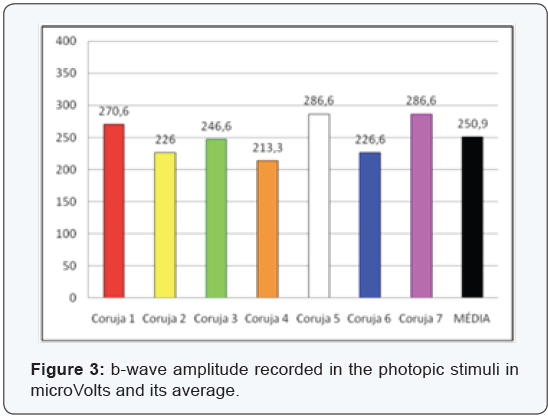
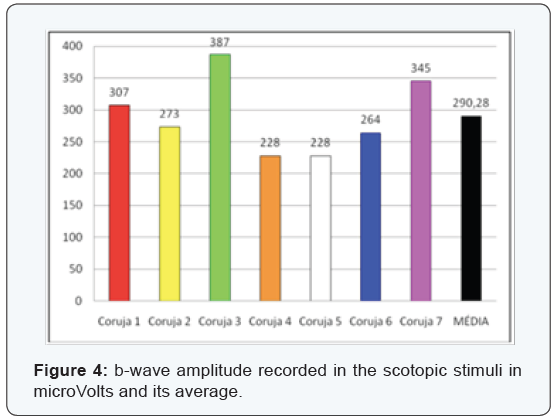
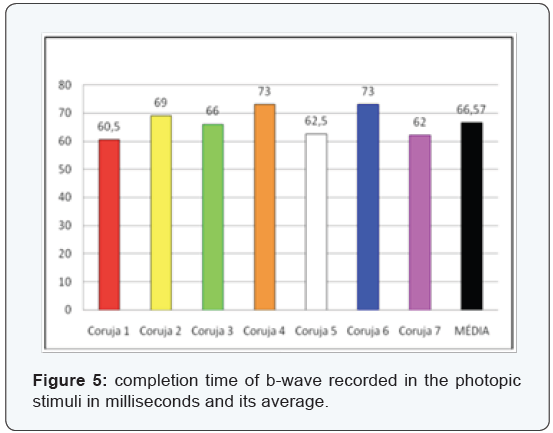
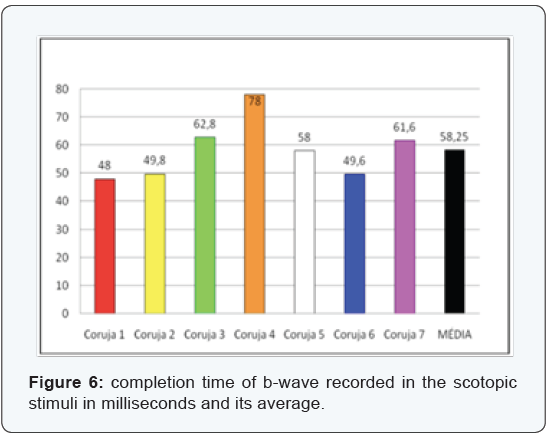
We used the t-Student two-tailed paired test due to the
small sample. The data evaluated in the species concerned are
unedited from a statistical point, and there are no reports in the
literature that refute or ratify why the determination of the “p”
value should not exclude data with significance under 95%.
Under the classical evaluation of Granit [28] we could
classify the Athene cunicularia retina as a type E, that is, an
excitatory type, with a clear PII component, or better, a b-wave.
This classification attributed to the retina of the excitatory type
a greater activity of the rods; however, now we know that the
b-wave is more related to bipolar, horizontal and Müller cells
[29-34]. Oscillatory potentials were observed, but were not the
object of this study.
The data from the study reflect the reality of the studied
species group, and documented all identified values.
The idea that we had in relation to the owls that they have the
ability to see either with light or in the dark, may not be confirmed
in other species and should continue to be investigated. Their
predatory activity and their life habit are due, no doubt, among
other characteristics, to the capacity of perception of the light
spectrum similarly in both photopic and scotopic stimuli.
The idea that we had in relation to the owls that have ability
to see the light and the dark, cannot be confirmed in other species
and should continue to be investigated. Their predatory activity
and its life habit are due, no doubt, among other characteristics,
to the capacity of perception of the light spectrum similarly in
both photopic and scotopic stimuli.
Conclusion
The comparative study of the retina in various vertebrate
classes has revealed important evolutionary aspects. The
Structural differences of the retina as a whole, as well as of
the cell types composing it allow us to try to correlate their morphology with the way of life of each animal [3].
The electroretinographic trace of Athene cunicularia under
white light stimulus of the white spectrum showed the a- and
b-waves, registering all variables proposed for study. From the
evaluated data, we can conclude that the retina of the species
studied should be classified as of an excitatory type, due to the
predominance of the positive component in the ERG.
When comparing the same variable (amplitude of the a- and
b-waves and completion time and latency of the b-wave) in both
photopic and scotopic stimuli, we observed that retinal electrical
response found is identical, confirming the hypothesis that the
retina of the studied species responds similarly to white light
in both stimuli. This peculiarity is responsible, among other
features, for the excellent twilight visual ability of the species,
and therefore, directly involved in their life habit. In the biological
sciences research the electroretinographic registration of Athene
cunicularia may then be a parameter for detailed studies of the
physiology of birds and for a better understanding of visual
perception as well as the study of eye diseases of the species.
Authors’ Contributions
MP initiated, planned and wrote the manuscript. LR
participates in drafting the article and revising it critically
for important intellectual content, as well as the analysis
and interpretation of data. EF participated in its design and
coordination. AM performed the statistical analysis and helped
to draft the manuscript, as well as give final approval of the
version to be submitted and any revised version. All authors
read and approved the final manuscript.
Acknowledgements
The authors thank Carlos Bastos for assistance in all
electrophysiological tests, being fundamental in this study;
and Fernanda Ramos, for her invaluable contribution in the
statistical support. This material is based on work supported
by the CEPAL under grant 14/2004 and IBAMA under grant
02022.000518/2005-33. Any opinions, findings and conclusions
or recommendations expressed in this article are those of the
authors and do not necessarily reflect those of the CEPAL or
IBAMA.
For more articles in JOJ Ophthalmology please click on:
https://juniperpublishers.com/jojo/index.php
https://juniperpublishers.com/jojo/index.php
No comments:
Post a Comment